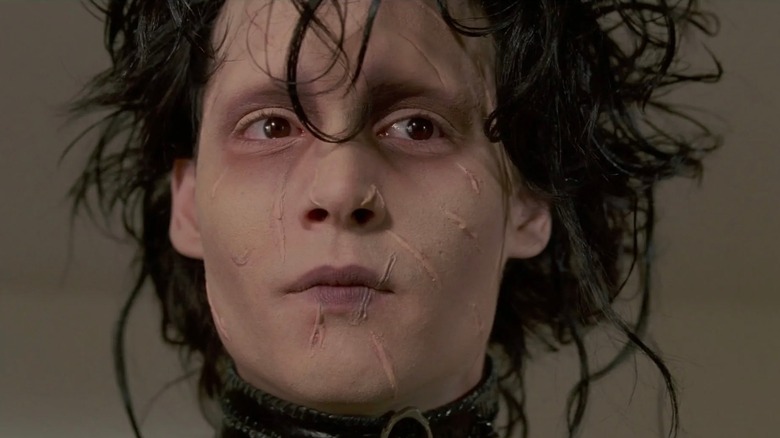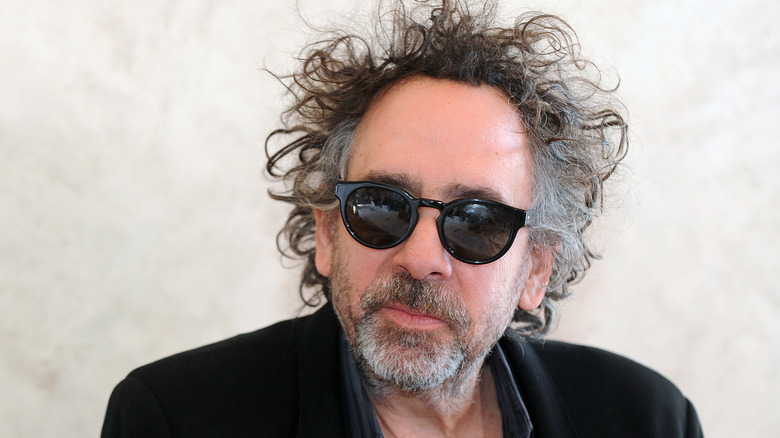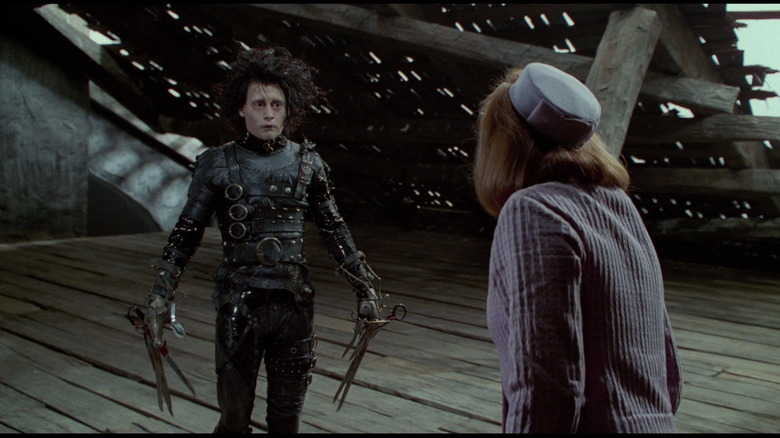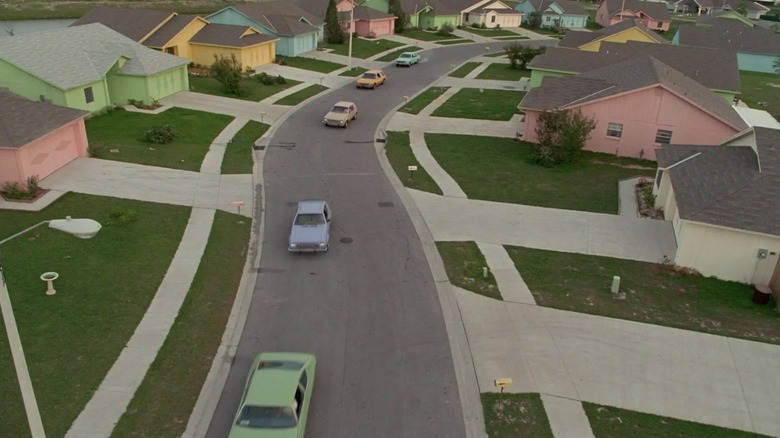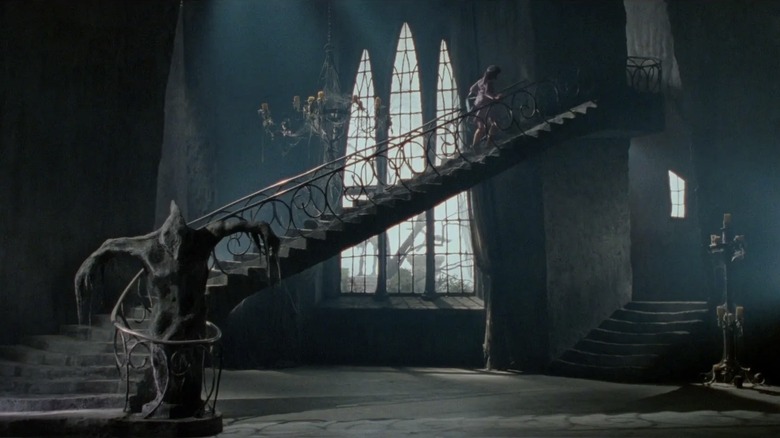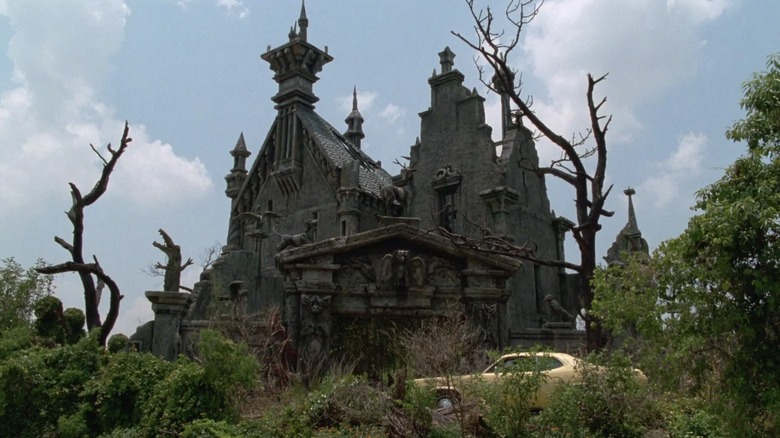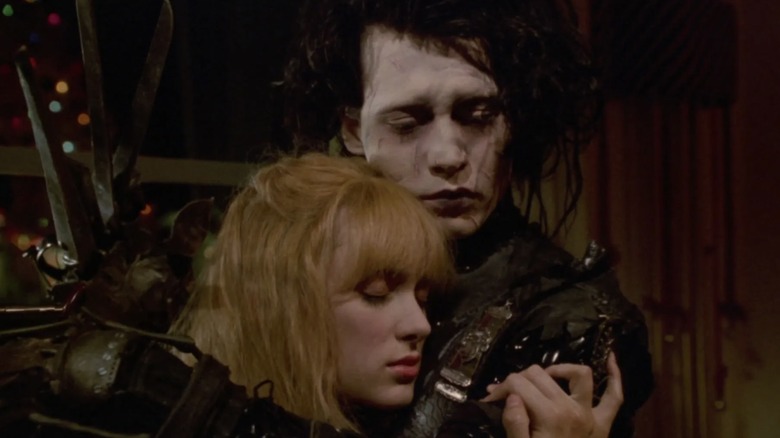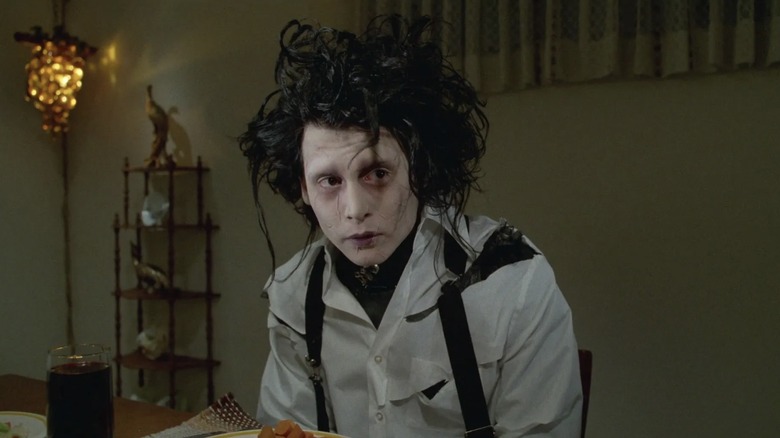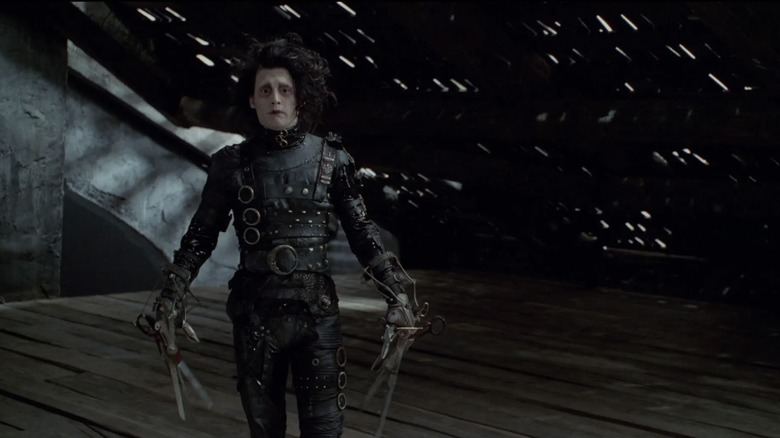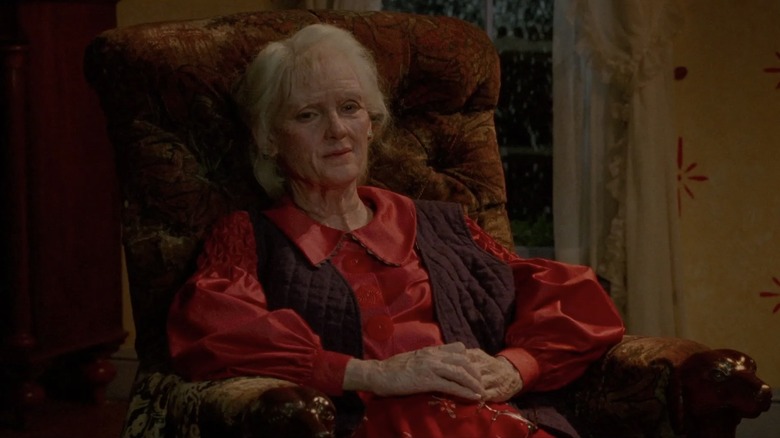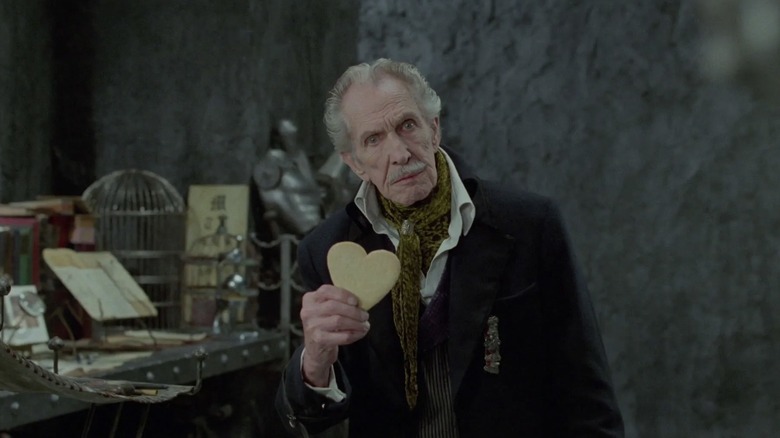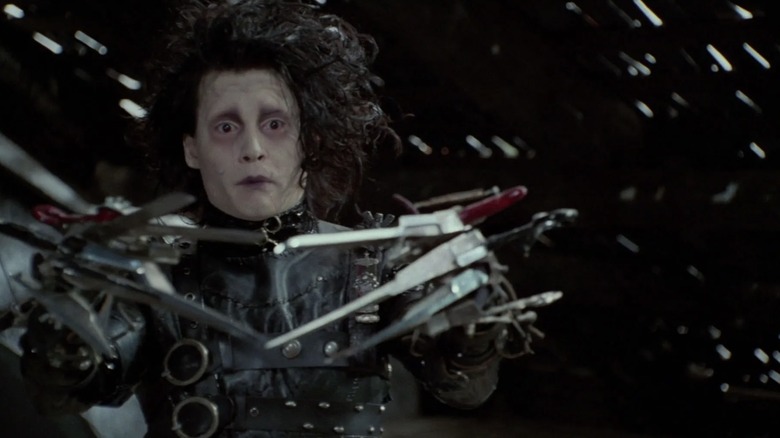The Dark History Of Edward Scissorhands
Tim Burton's "Edward Scissorhands" is a delightful fable about an artificial man, Edward (Johnny Depp), created by an eccentric Inventor (Vincent Price) who died before he could finish Edward. After The Inventor's death, Edward is left with scissors for hands, until the day Peg Boggs (Dianne Wiest), a tenacious Avon saleswoman, finds Edward in his crumbling gothic mansion, and brings him home to live with her family. Edward is soft-spoken, artistic, and beautifully tragic. He is also painfully awkward and nearly nonverbal, communicating with his expressive eyes and clumsy gestures.
When Edward arrives in Peg's colorful suburban neighborhood, he is welcomed as an oddity, giving the housewives in the neighborhood a brief reprieve from their boredom. Edward impresses them with his topiary, dog grooming, and haircutting skills, and soon finds himself a guest on television, and on his way to opening a salon. But, Edward's safety in this suburban landscape is contingent upon him understanding his place as an outsider.
When Edward falls in love with Peg's teenage daughter, Kim (Winona Ryder), Kim's territorial boyfriend Jim (Anthony Michael Hall) targets Edward. After helping Jim break into his own house, Edward is arrested. After his arrest, the neighbors shun Edward. He quickly becomes the subject of scrutiny and mistrust, leading to him being run out of this surreal suburbia back to his eerie mansion.
This film is funny, tender, and vulnerable, but it is also a little dark and melancholy, much like the director himself. Join us as we uncover the dark history of "Edward Scissorhands."
Tim Burton studied Character Animation at CalArts and worked at Disney
In 1976, Tim Burton enrolled at CalArts in the Character Animation Program hoping to become a Disney animator after graduation (via Vox). Burton told Vanity Fair that he joined "a collection of outcasts. You know, you usually kind of feel alone in that way, like you're the outcast in your school. And then all of a sudden you go to this school filled with outcasts!" Burton was in his element, and became part of a group of students from CalArts' nascent Character Animation Program that would usher in a second golden age of animation, reviving the industry.
Despite fulfilling his dream and working at Disney after graduation, Burton struggled to fit into the mold of a Disney animator. Burton told David Breskin of Rolling Stone, "I was just not Disney material. I could just not draw cute foxes for the life of me. I couldn't do it. I tried. I tried, tried. The unholy alliance of animation is you are called upon to be an artist, but on the other hand, you are called upon to be a zombie factory worker. And for me, I could not integrate the two." Burton explained how unhappy he was at Disney, coming close to a nervous breakdown.
After Burton and Disney parted ways, he found his footing as a director, and was soon regarded as a visionary in his field. After the enormous commercial success of "Batman," Burton took a step back from blockbusters, choosing to make a smaller and more personal film. He took inspiration from a character he created as a lonely teenager.
Edward Scissorhands was first born as a sketch
Tim Burton began drawing as a child, and he never stopped. As a teenager, Burton didn't fit in. He struggled to make and keep friends. One day, he sketched a sad-looking young man with scissors for hands, and felt connected to this character. This drawing of Edward was emblematic of the isolation Burton felt growing up as an outcast in sunny Burbank, California. This drawing, and the character Burton created in his mind, continued to haunt him through the years.
In a 25th anniversary article, "Edward Scissorhands" screenwriter Caroline Thompson told Dazed Digital, "Tim told me about a character he had who had scissors instead of hands and I said, 'Stop right there. I know exactly what to do with that,' and went home." Thompson sensed how desperate a boy with scissors with hands would feel to be held, and to hold someone. She understood the isolation Burton's character sprung from, and Edward became part of the story.
Producer Denise Di Novi told the Los Angeles Times, "In a way, Edward really is the metaphor for the artist who does not fit into the world." Others have called the film Burton's autobiography, but that is too close for comfort as he told The Guardian, saying "Like, I know that people say Scissorhands is slightly biographical, but if I think about it too closely I get freaked out. It's weird; I need to feel connected, but also distanced. That's why I don't write a lot."
The Burbank of Burton's youth inspired the suburbia of Edward Scissorhands
Burton told the Los Angeles Times, "A lot of it for me is the memory of growing up in suburbia. It's not a bad place. It's a weird place." He further explained their attempt to walk the fine line of "making it funny and strange without it being judgmental." Burbank had changed since Burton's youth, so they found a neighborhood in Florida to stand in. The art director, Tom Duffield, told Dazed Digital that Necco wafers inspired the color palette. While production designer, Bo Welch, told the Los Angeles Times that the "old circus colors" reflected the "faded optimism" of suburbia.
The visual juxtaposition in "Edward Scissorhands" between the pale-faced, leather-clad Edward who lives alone in a crumbling gothic castle, with the bright, candy-colored Boggs' neighborhood, is a perfect illustration of how out of place an angsty teenage Burton must have felt while growing up in his Burbank neighborhood. Burbank in the '60s and '70s was a sunny, all-American, suburban enclave where his peers were playing outside, while according to Vox, Burton preferred hanging out in cemeteries and watching horror movie marathons.
After moving to London, Tim Burton told The Guardian, "I always felt like a foreigner from the beginning of life, so when I actually became one, I felt more at home." Much like Edward and many other outcasts, Burton felt like his strangeness was amplified by the cookie-cutter suburban environment, and his film explores the pain of those of us who are incapable of assimilating and blending in.
German Expressionism heavily influenced Burton's visual style
You can't talk about Tim Burton movies without talking about his distinctive visual style. "Edward Scissorhands" was one of his earliest feature films where this stylized look, now called Burtonesque, was fully realized. But Burton developed his unique style based on the influence of German Expressionism. German Expressionism first developed as an art movement in Germany during and immediately after WWI, quickly spreading into cinema. According to Vox, in this highly stylized and surrealistic approach, filmmakers used distorted sets, high contrast, and dramatic lighting to create elongated shadows to heighten feelings of dread and fear. Expressionist films also featured unusual characters, and explored macabre themes like insanity, death, and chaos.
An excellent example of German Expressionism in cinema is the film "The Cabinet of Dr. Caligari," which some regard as the first horror film. We can see this foundational film reflected in "Edward Scissorhands" with the dramatic staircase in Edward's gothic mansion, and even in Edward's wild hair that resembles Cesare's from "Dr. Caligari." We also see influences of German Expressionism in Burton's film reflected in the stark contrast between Edward and his dark gothic castle, and the bright hyper-real suburbs where the Boggs family lives. There are also homages to Fritz Lang's "Metropolis" echoed in the robot assembly line The Inventor created in the mansion.
Edward Scissorhands is a modern gothic fairy tale
The term gothic was first applied to an architectural style in 12th century France. In the 18th century, it became linked to literature when gothic literature evolved out of the romantic movement (per Invaluable). Gothic literature is set in dark and atmospheric locations like haunted estates or crumbling castles, and the location is so important to the story it almost seems like a character. Gothic stories include supernatural elements, romance, and eroticism, with a hefty dose of tragedy. The hero of the story is usually an anti-hero, and gothic literature includes the damsel in distress archetype. Gothic stories are eerie, and they explore themes of isolation.
These themes and elements translated to films in the 20th century, creating the genre of gothic horror. "Edward Scissorhands" is more whimsical, funny, and quirky than traditional gothic horror. Still, it employs various elements from the gothic genre, such as Edward's castle, his deformity, and the doomed romance between Edward and Kim. The creation of Edward himself blurs the lines between science fiction and fantasy, introducing a supernatural element to the story.
Fairy tales bear a striking similarity to gothic fiction, despite predating the genre by thousands of years. It might be more accurate to say gothic fiction borrows distinctive elements from fairy tales. Sarah Ghoshal suggests in her academic paper, "The Gothic and the Fairy Tale: The Unified Genre," that gothic fiction just might be the grown-up version of fairy tales. Disney has sanitized fairy tales, but these stories have far darker origins, and more gruesome endings that fit perfectly within the conventions of gothic storytelling, making "Edward Scissorhands" a modern gothic fairy tale.
Links between Beauty and the Beast and Edward Scissorhands
Edward might not be furry, strapping, 7 feet tall, and dressed in a waistcoat, but in the pastel-colored suburban world Kim Boggs lives in, he certainly is beastly. Kim might need to live as a prisoner in Edward's crumbling gothic mansion for "Edward Scissorhands" to be a faithful retelling of "Beauty and the Beast," but the similarities between the two fairy tales are obvious. Just like in "Beauty and the Beast," Kim is initially repulsed by Edward. His scissors for hands, pale skin, and wild ebony hair make him look way too brooding for an archetypal blonde cheerleader to appreciate.
Still, just like Belle, Kim comes to appreciate Edward's gentle nature, his artistic talent, and his kindness. As the neighborhood turns against Edward, and Jim makes jokes at his expense, Kim comes to Edward's defense. Despite their surface-level differences, Kim realizes she has more in common with Edward than she does with the shallow and aggressive Jim, who is an excellent stand-in for Gaston from "Beauty and the Beast."
Tim Burton's fairy tale is a potent exploration of what it means to be different, and the isolation people like Edward and the Beast experience in a world that only sees their outer appearance rather than their sensitive souls.
Pinocchio is another inspiration for Edward Scissorhands
Edward's nose doesn't grow when he lies. If Edward even knows how to lie, he might be too pure for that. Still, the parallels are obvious between "Edward Scissorhands" and the classic fairy tale "Pinocchio," about a woodcutter who wants a son so badly he carves him from wood and wishes upon a star.
Both boys were created through craft and mysterious magic, and both boys want to be real. They both also struggle to understand the rules of society. Pinocchio is gullible, allowing himself to be led astray and away from school, only to be sold into slavery, performing as a marionette. When Pinocchio escapes with the help of Jiminy Cricket and the Blue Fairy, he is again duped into going to Pleasure Island rather than home to Geppetto, who is worried sick.
Edward is tricked into breaking into Jim's house and is arrested. The scene where Bill Boggs (Alan Arkin) tries to explain ethics over dinner to Edward bears similarities to Jiminy Cricket trying to explain what a conscience is to Pinocchio. When Edward reveals to Kim that he knew it was Jim's house, but he did it for Kim, we realize Pinocchio might be a fool, but Edward is a fool for love. Pinocchio gets his wish and becomes a real boy, but dear Edward returns to his crumbling mansion to live in isolation, giving this film a decidedly dark twist.
The connection between Frankenstein and Edward Scissorhands
Like "Frankenstein" before it, "Edward Scissorhands" is about the lonely life of a mad scientist's creation after being abandoned by their maker. In Edward's case, The Inventor dies before he can complete Edward, leaving him with scissors for hands. But The Inventor loved Edward, treating him like a child, rather than an abomination as Victor Frankenstein did in the classic horror story. Victor Frankenstein is horrified by his creation, abandoning him in an unwelcoming world.
Tim Burton acknowledged the inspiration "Frankenstein" gave him, telling the Belfast Telegraph, "I don't know why, but I always related to characters like Frankenstein. I think a lot of kids do; it's easier to relate to the monster in the sense of he's alone. Growing up, you could feel those feelings and the way you felt about your neighbors is like they're the angry villagers." In Mary Shelley's genre-bending classic about a mad scientist who thinks he can cheat death, it is Frankenstein's creation who has no name; in Burton's gothic fairy tale, it is The Inventor who has no name. Perhaps this distinction highlights the underlying message of "Frankenstein?"
When Edward is brought to the hyper-reality of Peg Boggs' suburban neighborhood, Edward is first embraced as an oddity, but much like the creation in Mary Shelley's "Frankenstein," Edward is soon shunned and run out of town by an angry mob who believes him guilty of a crime. These "monstrous" creations might have more humanity in them than the people who created them. This is something Burton captures beautifully in "Edward Scissorhands," while screen adaptations of Shelley's novel have never achieved this nuanced portrayal of Frankenstein's creation.
Peter Pan and Wendy inspired screenwriter Caroline Thompson
Scenes where an elderly woman tells her granddaughter a story as snow falls outside frame the tale of "Edward Scissorhands." Screenwriter Caroline Thompson told Insider, "The great sadness of Edward is the same as it is for Peter — he never ages. I was evoking Wendy with Kim at the end when her granddaughter says, 'Why don't you go see him?' And she says, 'I want him to remember me the way I was.' That moment was very important to me."
With this statement, Thompson evokes not how Peter and Wendy's story ended in the animated Disney adaptation, but how their story ended in the 1911 book "Peter and Wendy." Peter flies into the nursery window one night to discover that since the last time he visited, Wendy had grown up and now had a child of her own. This ending might seem sad to those of us who are old enough to understand the heartache of nostalgia, but Peter is, as the book says, "innocent and heartless," suggesting this is only tragic for Wendy.
Kim certainly understands this bittersweet nostalgia about the beautifully tragic boy who got away. Seeing, in the final moments of the film, what Edward is carving from ice to make the snow that blankets suburbia, we have a feeling Edward also finds it tragic. The sculptures depict his time with Kim. Edward might be innocent, but he isn't heartless.
The Inventor was written specifically for Vincent Price
Tim Burton idolized Vincent Price, and loved Price's horror movies growing up. Burton wrote the part of The Inventor specifically for Price. Although the role was supposed to be larger, it was reduced because Price was ill during filming. Sadly, "Edward Scissorhands" would be Price's last big screen role (per Insider). Price had worked with Burton earlier as the narrator of the animated short film, "Vincent," about a boy who loved Vincent Price and daydreamed about being his idol.
Before "Edward Scissorhands" hit theaters, Burton confessed to the Los Angeles Times, "I can't tell you what (Price) meant to me growing up. This sounds dramatic, but he helped me live ... When you're a child and a teenager it's not unusual to go through a melodramatic phase. Some people find release through heavy metal or whatever. But by watching (Price's) films, there was a catharsis for me."
This statement not only highlights Burton's cinematic inspirations for this film, but also the isolation and pain he experienced as a teenager growing up in Burbank. Being a sensitive, and admittedly weird artist type in an environment that demands conformity can be painful for a young person. Burton examines this isolation beautifully in "Edward Scissorhands." Price was the perfect casting choice for The Inventor. He was just eccentric enough to be a mad inventor, but also had a warm, grandfatherly vibe that suited the character perfectly.
Monster movies also inspired Edward Scissorhands
It should come as no surprise that Tim Burton loved monster movies growing up, and always identified with the monsters more than the humans. This affinity was an inspiration for the creation of Edward, a tragic monster with an artist's soul. Burton told the Los Angeles Times, "I'm hoping the feelings are fairly universal," adding that the film "is not a new story. It's 'Frankenstein.' It's 'Phantom of the Opera.' It's 'Hunchback of Notre Dame,' 'King Kong,' 'Creature from the Black Lagoon,' and countless fairy tales."
Per Vox, sci-fi and horror b-movies were a huge influence on Burton's aesthetic, and the themes he explores in his films. Burton even provided a list, including movies like "The Mummy's Tomb," "Nosferatu," and "Revenge of the Creature." Burton told Danny Elfman during a discussion for Interview Magazine, "The thing I love about the old monsters is that they had such a strong, immediately identifiable image ... Even in 'Creature From the Black Lagoon' [1954], the guy had a complete costume, so you felt like there was a human being underneath."
Johnny Depp's Edward exudes vulnerable humanity with his sad, expressive eyes. As Burton told David Breskin of Rolling Stone, the tragedy of Edward and monster movies is they are about characters who are misperceived. "I love a character that is open and sensitive to everything," he said. "There is something very funny and tragic about that." Burton linked this to Depp himself, telling Elfman for Interview Magazine, "Johnny's not 'Tiger Beat,' even if that's how the rest of the world saw him ... He's got a lot more depth, a lot more emotion. There's a certain sadness when that happens to people." A lot of heart went into creating "Edward Scissorhands," and Depp was the perfect actor to bring him to life.
